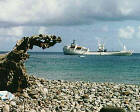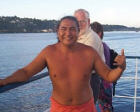As a young man, just out of my teens, I got interested in the South Pacific and for several years I read everything on that part of the world. Now, after almost fifty years, Lovey and I were able to spend a month in French Polynesia.

For most of that time we traveled the Marquesas Islands, approximately 750 miles north of Tahiti. This a spectacular area, very isolated but magical and beautiful. We had heard about the passenger-freighter, the Aranui, for a long time. It is the main link the Marquesas have with the outside word and makes a trip about every month bringing in all sorts of needed supplies and picking up copra, which is one of their main sources of income. Lucky for us it also takes about 100 passengers as well as natives who sleep on the rear decks.
The ship is about 30 years old and has been in this service for nine years. It seems tired as it gets a lot of use but this fact in no way diminished the joy of the trip. About one third of the space is devoted to the passengers and the rest to cargo. The ship’s crew are delightful and very interesting, most being native Polynesian cargo handlers.
The Marquesas have almost no piers or docks to land. We went ashore in whaleboats, but most interesting was that almost all cargo was delivered in the same whaleboats through the surf to shore. One of the highlights of the trip was to watch the sailors handle cargo and get it to shore.
What is life like aboard the Aranui?
After climbing the 25 steps (with metal railing on both sides) to come aboard, one enters the reception area. On the right is the dining room. On the same deck is the boutique, which is open a few hours each day to sell clothing, postcards. candy, film, bug oil, etc. Also on that same level is the lounge with fairly soft chairs, a long conch along two walls, and six small low tables suitable for card playing, but not quite card table height. Bring a book from home or choose from the hundred or more paperbacks left by previous passengers. A selection of local interest books can also he checked out from the reception desk. Scrabble, backgammon, and Trivial Pursuit are also available. Down a hallway is the hospital. There is usually a doctor aboard on a one voyage basis, but the line cannot guarantee it.
Up one flight of steps is the video room which one can choose from a selection of movies listed at the reception desk. The VCR will play a VHS tape from the U.S. or a video recorded on the trip can be played. The video room is in the older part of the ship. This is also where the four outside B cabins are located and where the islander deck passengers are.
One deck above this is where the tourist deck passengers reside in Category C accommodations. Extensively remodeled in early 1996, Category C is now 20 dormitory style bunks in a large air-conditioned common room. Many bunks have Individual reading lights and pretty blue Tahitian print privacy curtains over the entrances. There are ladders to the top bunks. Below the bunks are two locked drawers about one foot high, the depth of the bunk and half the length of the bunk; there is one drawer for each person. Scattered throughout the area are hanging racks and open shelves. At the end of the room are two bathrooms with toilets and sinks. Two shower rooms, and one combination bathroom-shower room.

Category C passengers enjoy all the same dining, lounging, and shore excursion privileges as the cabin passengers. Obviously there is no single supplement needed for this Category. This is a no smoking area. Outside the Category C area is another lounge with TV and VCR. One deck above is the bridge, where passengers are usually welcome to visit at any time. Climb an outdoor ladder and one has the highest view from the ship!
Read Part 2